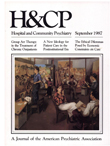Short-Term Psychiatric Hospitalization of Children
Abstract
Recent changes in psychiatric practice, fueled in part by national economic trends, have contributed to the increasing use of short-term psychiatric hospitalization for children. The authors discuss specific approaches to treatment planning, milieu therapy, family work, and individual therapy that help maximize a patient's stay on the short-term psychiatric unit for latency-age children at Tulane University Hospital. Data on diagnosis and length of stay of children admitted during the first two years of the unit's operation are presented, and specific attributes of latency development that affect the short-term process are discussed.
Access content
To read the fulltext, please use one of the options below to sign in or purchase access.- Personal login
- Institutional Login
- Sign in via OpenAthens
- Register for access
-
Please login/register if you wish to pair your device and check access availability.
Not a subscriber?
PsychiatryOnline subscription options offer access to the DSM-5 library, books, journals, CME, and patient resources. This all-in-one virtual library provides psychiatrists and mental health professionals with key resources for diagnosis, treatment, research, and professional development.
Need more help? PsychiatryOnline Customer Service may be reached by emailing [email protected] or by calling 800-368-5777 (in the U.S.) or 703-907-7322 (outside the U.S.).



